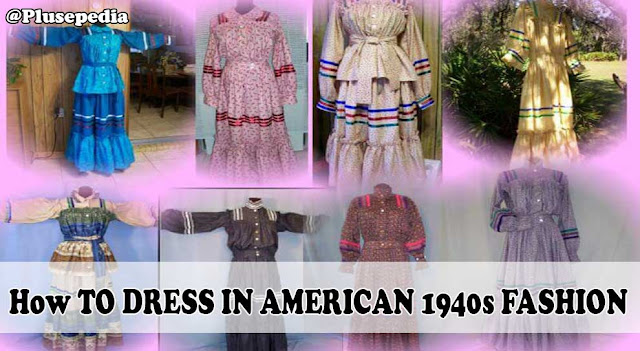Fashion from the 1940s includes several classic components that you can include into modern clothes. You can dress in the 1940s American wartime look as well as the post-war late-40s appearance. Combine a few essential things to your wardrobe and know how to pair them together. You're going to be rocking a fabulous vintage look in no time!
1. Be adaptive.
Here is a couple of trends which were directly influenced by substances rationing. Remake what is old. Both people reused and retailored outfits left over in the 1930s. To adapt current trends, girls would shorten the timeless drop-waist of the '30s shape to break at the more stylish natural waist. Hemlines were even higher than previously! Also, as more American men drafted, girls at home remade their left-behind clothes into slim-fitting trousers, blouses, and jackets are far more usual for the more busy lives they needed to direct. Less cloth became the thing to do. Women's hemlines were raised to store on fabric, and their clothes kept to a slim cut with minimal embellishment. For the very first time, women started wearing pants in masses to boost employee safety.Musicians and mobsters wore full, fancy zoot suits, but many American guys could purchase "success suits" that provided no rolled cuffs on the pants, no sleeve buttons, without a patch pockets, along with shorter coats and thinner trousers. Waistcoats or vests left in favor of double-breasted suits coats. Wear dull colors. Brown and green dyes significantly rationed to used in army uniforms. In answer, dark maroon, gray, or undyed beige or white fabrics offered for modern usage. Bright neon colors weren't seen in clothes because chemical dyes utilized. Girdles were made rare by rubber rationing during the war. In reaction, most women's skirts and trousers featured elastic waistbands that demanded no fasteners and might fit an assortment of sizes. Undershirts had dropped from hot fashion for men throughout the breed of the Great Depression, and following Clark Gable was envisioned without one at the 1934 film It Happened One Night. Possibly the most iconic thing to be rationed during the war was women's stockings. After both nylon and silk became rare, girls would paint their thighs a slightly darker tone and then utilize black liquid liner to draw the customary seam up the back of the leg to provide the look, from far out, of lace stockings.2. Play up the wartime silhouette.
As women's skirts and gowns became shorter to save on cloth, legs appeared as the most notable and desirable quality of the early-1940s figure. Also, as men and women's clothes stuck to slim cuts through the entire body, shoulder pads became more popular for both genders as a means to add interest to the shape.3. Wear war-appropriate shoes.
Since rubber has been in short supply, stainless steel pumps and wedge pumps gained fame with American girls. To save on shoe leather, peep feet, and T-straps became trendy. Flat, utilitarian sneakers were also a sensible everyday selection for women working in factories.4. Pay more attention to hair.
Although men's haircuts retained a lot of their smooth appearance they had needed during the 1930s - or flipped to buzz cuts, such as honorable soldiers - girls utilized hairstyles as a means to continue being fashionable regardless of fabric rationing. Trims were pricey and short hair is hard to tie back in the office, great guards were in fashion. Europeans dominated the hat marketplace from the 1940s, American women started to prefer smaller hats or no hats whatsoever. Complicated styles -like success rolls, pin curls or finger waves have been more popular, as were ribbons, headbands, and other antiques.5. Feminize an austere look with makeup.
Bold makeup was just another route by which American girls sought to bring a female angle to everyday clothes. Eye makeup has been retained quite tame, with eyeliner and mascara on the upper lid. Eyebrows were arched more naturally but had an arc which could only reach with tweezing and forming. Vibrant, matte lip colors, like coral pink or fire-engine crimson, ruled daily. Tangee lipstick, the first color-change lipstick, remains offered. Nail color matched a lady's lipstick color.6. Add accessories.
Gloves were less crucial to finish a female's looks than they were in the 1930s (and significantly less than they'd be again in the '50s), nevertheless turned into a favorite staple. Handbags and pocketbooks were trendy, also. For guys, a fedora tipped at a jaunty angle has been the hat of selection.After 1947 many changes in fashion:
1. Dress for luxury.
Since America slipped into post-war wealth after 1945, styles became more complicated and indulgent again. Listed below are a couple of examples of the trend. Christian Dior's "New Look" silhouette, released in 1947, was an immediate reaction to the wartime austerity look. It comprised a tailored, pleated coat with a nipped waist and a peplum (a little skirt highlighting a narrow waist and broad shoulders) that flared out to a mid-calf length, full skirt composed of springs. Rather than the leggy wartime appearance, the New Appearance emphasized the breasts and buttocks in an hourglass figure. The outfit completed with a hat, gloves, jewelry and a handbag or pocketbook, and it came in some colors.Wear cocktail apparel. Cocktail apparel, charged as more tasteful than day wear but a step down from formal wear, became increasingly popular in the late 1940s for casual or early dinners. For girls, this meant wearing dresses in sumptuous fabrics using a mid-calf or knee-length hem and including components like a low-cut bodice, a short bolero coat, or a frothy skirt enriched with tulle or chiffon. Furthermore, high heels became great, and wedges were less popular.


No comments:
Post a Comment